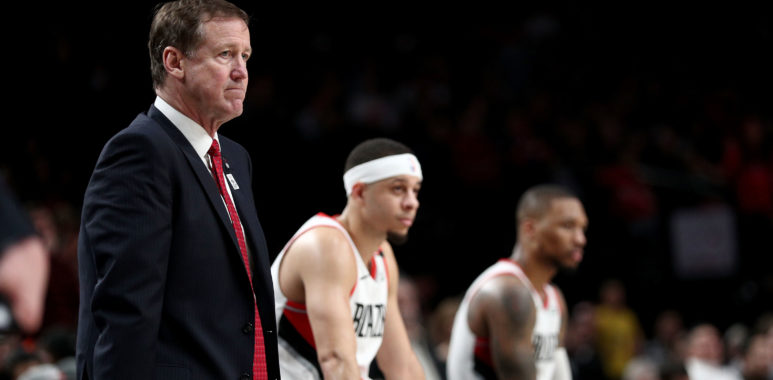
Nurkic’s Injury Ended Trail Blazers Playoff Hopes
The Trail Blazers lost more than their starting center when Jusuf Nurkic broke his leg against the Nets last week — they lost any hope of winning a playoff series.
That may sounds hyperbolic, but it’s dangerous to underplay how integral Nurkic has been to the Blazers success this season:
Fun fact: Nurkic is No. 2 in the entire western conference in net rating this season. Behind only Steph Curry.
If Pascal Siakam didn't exist, Nurk would be a sneaky Most Improved Player candidate. It's hard to overstate how far he's come.
— Eric Griffith (@EricG_NBA) March 26, 2019
What he does on offense
On offense Nurkic is a multi-faceted big man that takes pressure off of Blazers star Damian Lillard. The two have developed excellent chemistry in the pick and roll, with Nurkic using strong rolls and a new-found patience around the rim to score against rotating defenses when the offenses overload on Lillard.
Big man passing is a sneaky staple of head coach Terry Stotts’ offense and Nurkic has learned to exploit the opportunities he’s given. Nurkic has become a dangerous passer out of the elbow, regularly exploiting defenses scrambling to get the ball out of Lillard’s hand. His assist percentage has jumped from 11.7 percent to over 18 percent this season.
Nurkic’s true shooting percentage has jumped to 57 percent this year — up from 52.8 last season. This can mostly be attributed to increased confidence and patience around the rim. Last year Nurkic would regularly resort to “flippy sh*t” when posting up, but this season he was more likely to take his time and use his size and skill to beat a defender. The result is a massive increase in free throw rate from .287 to .442.
Nurkic is still shooting 58 percent within five feet of the hoop when he’s not fouled, among the worst in the NBA for centers, but the additional free throws and assists have had a significant impact on his overall offensive game. For the first time in his career, posted a positive offensive box plus/minus and his offensive win shares jumped from 0.8 last season to 4.4 this season.
The improvements are further reflected in Basketball Index’s player grades. Nurkic has jumped from the 62nd percentile to the 85th percentile in overall offense, as well as major improvements in one-on-one play, roll gravity, and playmaking.
Nurkic’s impact on defense
On defense Nurkic plays backstop to help support the generally poor defense of Portland’s starting guards. He often challenges penetrating guards around the hoop after they are herded into the lane by a trailing guard. Nurkic does not have the mobility of “switch-everything” centers like Clint Capela, but he has the size and skill to snuff out shot attempts near the rim. The Blazers rely on the hesitancy of modern offenses to shoot in the mid-range to goad smaller players into the lane in an attempt to challenge Nurkic.
ESPN’s Kevin Pelton confirms Nurkic’s stout defense near the basket:
Stotts’ defensive scheme calls for the screener’s defender to drop back into the paint on pick-and-rolls, protecting the rim. The 7-foot Nurkic excelled in that scheme, using his size to intimidate in the paint. Per Second Spectrum tracking on NBA Advanced Stats, the 55.9 percent of shots inside 5 feet opponents have made with Nurkic as a primary defender ranks in the top 20 among players who have defended at least four such shots per game. Between New York and Portland, Kanter has allowed 64.8 percent shooting to opponents in the same situations. And coming to the Blazers’ scheme hasn’t helped: Opponents are shooting 71.4 percent against Kanter in Portland.
Add in a solid defensive rebounding percentage of 57 and it’s no surprise Nurkic has an overall defensive grade in the 95th percentile according to Basketball Index, and a career high defensive box plus/minus of 3.6.
Why are the Blazers screwed?
Nurkic’s (relatively) modest 15.6 points and 10.4 rebounds per game belie his overall impact. Even when he’s not putting up a 20+ point, 20+ rebound 5×5 game, he plays a vital role creating space for Lillard on offense and offsetting the defensive weaknesses of the perimeter players.
Unlike CJ McCollum, who can be replaced in the short term by Rodney Hood and Seth Curry, the Blazers have nobody on their roster who can fill the gaps left by Nurkic. McCollum’s impact is also limited to scoring, with lesser ripple effects to his teammates.
Enes Kanter might be able to replace most of Nurkic’s impact on offense and create gravity to help Lillard — he’s already looking more comfortable as a secondary playmaker — but he’s hopeless on defense. Zach Collins, conversely, has proven himself to be a competent defender but has limited (to put it charitably) offense and plays best at power forward. That leaves Meyers Leonard and, well, playing him 30 minutes a night won’t end well.
Without a back-up player who can replicate even half of Nurkic’s impact as a two-way player, the Blazers will likely find themselves in a similar situation in the playoffs as last season. Relying entirely on Damian Lillard to create offense, with Al-Farouq Aminu shooting bail-out 3-pointers, while the defense struggles to contain opposing guards. Unforunately, Nurkic’s injury ended not just his season, but the Portland Trail Blazers’ season as well.
